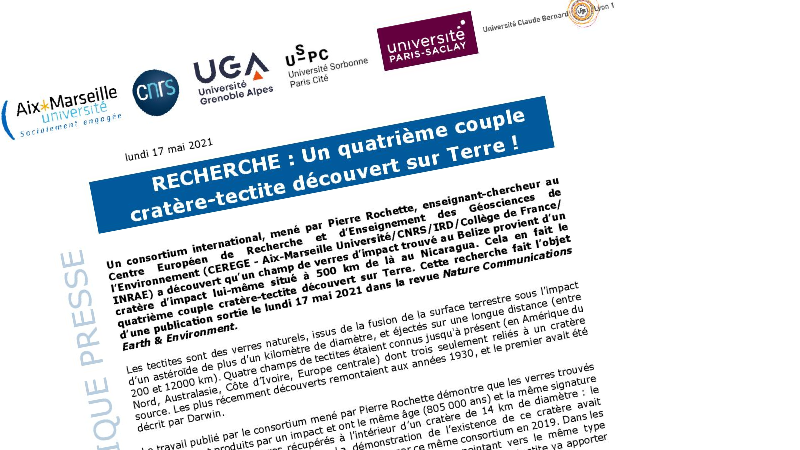
An international consortium, led by Pierre Rochette, professor at the Centre Européen de Recherche et d'Enseignement des Géosciences de l'Environnement (CEREGE - Aix-Marseille Université/CNRS/IRD/Collège de France/ INRAE) has discovered that a field of impact glass found in Belize originated from an impact crater located 500 km away in Nicaragua. This makes it the fourth crater-tektite couple found on Earth. This research is the subject of a publication released on Monday 17 May 2021 in the journal Nature Communications Earth & Environment.
Tektites are natural glass, resulting from the fusion of the Earth's surface under the impact of an asteroid of more than one kilometer in diameter, and ejected over a long distance (between 200 and 12000 km). Four tektite fields were known until now (in North America, Australasia, Ivory Coast, Central Europe), of which only three were connected to a source crater. The most recent discoveries were made in the 1930s, and the first was described by Darwin.
More information: "Impact glasses from Belize represent tektites from the Pleistocene Pantasma impact crater in Nicaragua" by P. Rochette et al, in press in Nature Communications Earth & Environment
This research was conducted in France by the Centre Européen de Recherche et d'Enseignement des Géosciences de l'Environnement (CEREGE, Aix-Marseille Université/CNRS/IRD/Collège de France/ INRAE), the Institut de Planétologie et d'Astrophysique de Grenoble (Université Grenoble Alpes/CNRS), Institut de Physique du Globe de Paris (Université Sorbonne Paris Cité/CNRS), Laboratoire des Sciences du Climat et de l'Environnement (CEA/UVSQ/Université Paris-Saclay) and Laboratoire de Géologie de Lyon: Terre, planètes, environnement (Université de Lyon/ENSL/UCBL/CNRS), and internationally by the Centre for Star and Planet Formation at the Globe Institute of the University of Copenhagen, the Laboratoire G-Time of the Université Libre de Bruxelles and the School of Earth and Planetary Sciences of Curtin University, Perth.
Centre Européen de Recherche et d’Enseignement des Géosciences de l’Environnement
Pierre Rochette – Enseignant-Chercheur
rochette@cerege.fr

